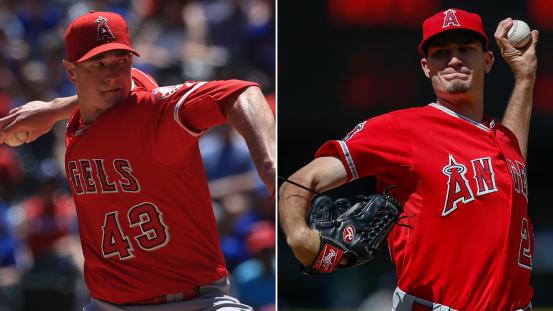- Commissioner’s statement on Ventura, Marte
- Ronnie O’Sullivan: Masters champion ‘felt so vulnerable’ in final
- Arron Fletcher Wins 2017 WSOP International Circuit Marrakech Main Event ($140,224)
- Smith challenges Warner to go big in India
- Moncada No. 1 on MLB Pipeline’s Top 10 2B Prospects list
- Braves land 2 on MLB Pipeline’s Top 10 2B Prospects list
- Kingery makes MLB Pipeline’s Top 10 2B Prospects list
- New Zealand wrap up 2-0 after Bangladesh implosion
- Mathews, Pradeep, Gunathilaka to return to Sri Lanka
- Elliott hopes for rain for Poli
Richards, Heaney put faith in stem-cell therapy
- Updated: May 26, 2016

ANAHEIM — On May 2, Steve H. Yoon, a physician at the Kerlan-Jobe Orthopaedic Clinic in Southern California, extracted stem cells from Andrew Heaney’s bone marrow and injected them into the damaged ulnar collateral ligament in his elbow. Fourteen days later, Yoon did the same with Garrett Richards.
Now the Angels’ two best, most promising starting pitchers are left to wait, and hope.
If the stem-cell therapy works, Heaney and Richards will be lined up to pitch for a full season in 2017 and may even be able to contribute toward the end of this very summer. If it doesn’t, they will undergo Tommy John surgery that, at this point, is certain to knock them out until the start of 2018.
It is a franchise-altering set of circumstances, especially for an Angels organization that carries a depleted farm system and a maxed-out budget.
The consensus from within seems to be that this is at least worth a shot.
“There are examples of pitchers that have opted to go the conservative-care route and it has worked for them,” Angels general manager Billy Eppler said. “I think the last thing that we want to do as an organization is push a guy towards surgery. One of the unanimous pieces of advice that these guys get from the doctors is to not go to the operating table unless you are at a point of being 100 percent convinced that it is your only option to heal your arm, and that you feel you’ve exhausted every other option.”
PRP vs. stem cells
Six years ago, Yoon began treating partial UCL tears with platelet-rich plasma injections, wherein a patient’s blood is spun in a centrifuge to concentrate the platelets, which contain healing elements that are then injected into the affected area.
Yoon found that PRP worked for about 50 percent of patients. But in that time he also experimented with the use of stem cells from concentrated bone marrow and “noticed that the success rates, anecdotally, were much higher with regards to pitchers going back to throwing, and not having to undergo surgery.”
Yoon estimates that he has performed stem-cell procedures on 15 to 20 Major League pitchers and that “less than 50 percent” ultimately needed Tommy John surgery, though he is not allowed to reveal the names of his patients. The results can be misleading, in both directions, because success is contingent on the type of tear and the amount of time allotted for healing.
Dr. David Crane, who specializes in regenerative therapy for Blue Tail Medical Group in the Midwest, said he has done about 50 of these stem-cell procedures since 2004, the vast majority of them for pitchers in high school and college. About five were Major Leaguers, and Crane said only one wound up needing Tommy John surgery. He claims to have a 90-percent success rate overall, but he is also picky with the patients he chooses.
Said Crane: “If it’s a partial tear, and they still have the healing potential, and the stem cells from bone marrow are good, it’s a useful tool.”
Mixed results
Major League players have used PRP to treat a variety of ailments over the last 10-plus years. And ever since Bartolo Colon used stem cells from his own bone marrow …
continue reading in source mlb.mlb.com
